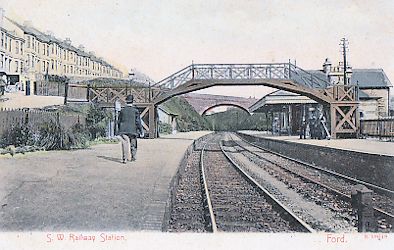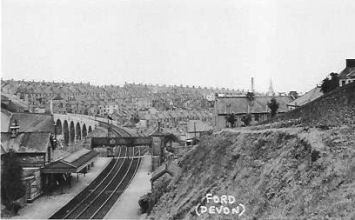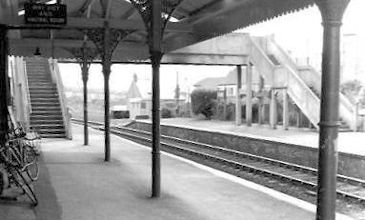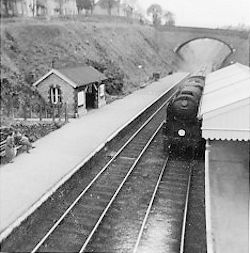|
OLD DEVONPORT
. UK |
||
|
© Brian
Moseley, Plymouth Webpage created: February 14, 2016 Webpage updated: February 09, 2022 |
||
|
RAILWAYS IN OLD DEVONPORT
|
PLYMOUTH, DEVONPORT AND SOUTH WESTERN JUNCTION RAILWAY COMPANY FORD STATION
A view from the southern end of Ford LSWR
Station
Ford Station
looking towards Ford Viaduct and Devonport. Ford Station was situated at the eastern end of Station Road, Keyham Barton, between Saint Budeaux Victoria Road Station and Devonport King's Road Station on the British Railways Southern Region main line through Devonport.
The concrete footbridge at Ford Station. The Station was constructed by the Plymouth, Devonport and South Western Junction Railway Company and opened when that Company's line from Lydford to Plymouth was opened for passenger traffic on Monday June 2nd 1890. The booking office and facilities were on the Down side, entered form Sussex Road. A shelter was the only building on the Up side, which was accessed by crossing the tracks from the Down platform because there was no footbridge. At the Devonport end of the Up platform was the Ford Signal Box, which was brought into use on May 12th 1890. A single siding was also provided on the Up side, by the signal box, mainly used for unloading bricks for the Keyham Barton housing development that was under construction. It was brought into use on Thursday February 1st 1900. After the Keyham Barton Estate was built a footbridge was provided to link it with the Down platform. To the south of Ford Station were several engineering features: Ford Viaduct, Ford Tunnel and Devonport Park Tunnel. As from Wednesday March 1st 1905 quarterly season tickets were available by the London and South Western Railway between Ford Station to Friary Station for £1 7s 6d first class, £1 2s 6d second class and 18s third class; also to Mutley Station and North Road Plymouth Station for £1 first class, 15s second class and 12s third class; and to Devonport Station for 15s first class, 10s second class and 8s third class; and to Saint Budeaux Station for £1 first class, 15s second class and 12s third class. For Departures from Ford Station in June 1914 CLICK HERE. The first Station Master, Mr William Thomas Brown, from Gosport, in Hampshire, served at Ford Station for 30 years from the opening until his retirement in 1920. Although the station name boards were never altered, the name in the public timetables was changed in July 1923 to Ford (Devon) Station in order to avoid confusing passengers who may have thought it was Ford Station in Sussex. Ironically, the only train that passed through both Ford Stations, the Atlantic Cost Express, did not stop at either of them. By 1932, when only one freight train, the 8.12am from Friary to Exmouth Junction Goods Yard, was booked to call between 8.50 and 9.05am, all of the track relating to the siding and crossover had been removed. Mr P C Hayman, Station Master at Friary Station, was responsible for Ford (Devon) Station in June 1948 and Mr F J Hammett of Friary Goods Depot was responsible for the goods traffic. On Weekdays and Sundays, 'where train service permits', commencing on May 1st 1953, the following cheap day return tickets, first and third class, were available from Ford (Devon) Station to: Bere Alston, 3 shillings (s) 1st, 2s 3rd; Bere Ferrers, 2s 3d 1st, 1s 5d 3rd; Brentor, 6s 9d 1st, 4s 6d 3rd; Bridestowe, 8s 3d 1st, 5s 6d 3rd; Callington, 6s 6d 1st, 4s 3d 3rd; Calstock, 3s 9d 1st, 2s 6d 3rd; Gunnislake, 4s 9d 1st, 3s 3d 3rd; Lydford BRSR, 7s 6d 1st, 5s 3rd; Tavistock North, 5s 3d 1st, 3s 6d, 3rd. Tickets were valid for return from Lydford BRSR Station, Lydford BRWR Station, Tavistock North Station, or Tavistock South Station by either route. Interesting that these cheap tickets were available from Ford (Devon) Station to Bridestowe but not to Okehampton. For Departures from Ford Station in June 1954 CLICK HERE. According to the "The Official Hand-book of Station 1956" Ford Station only dealt with passengers, parcels and miscellaneous traffic.
A London Waterloo to Friary trains speed
through Ford Station in the 1960s. Mr William Kimberley Goodman, born at Saint Teath, Camelford, Cornwall, began his railway career with the London and South Western Railway Company as a porter. By 1951 Mr Goodman was living in the railway house at Ford Station, Plymouth. He was presumably the booking clerk-cum-porter up until the Station closed. Mr William Kimberley Goodman died in Plymouth on May 7th 1967. (SEE "Who was Who in Old Devonport - G"). Ford Station was closed to both goods and passenger traffic as from Monday September 7th 1964 when the line between Devonport King's Road Station and Saint Budeaux Victoria Road Station was closed because it duplicated the Western Region main line. It is not recorded when the station buildings were demolished.
|
||



